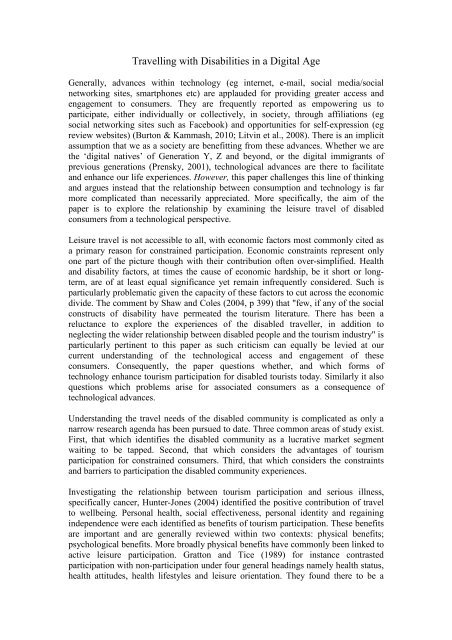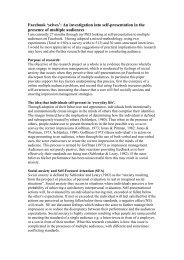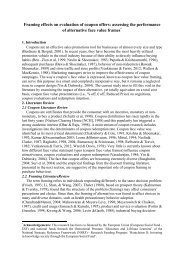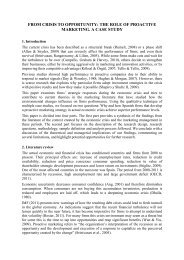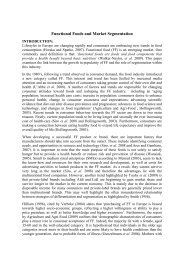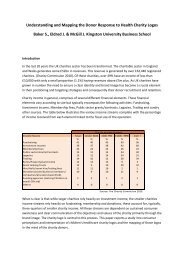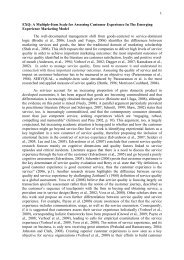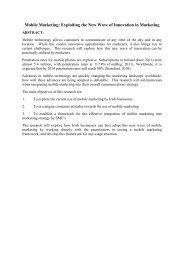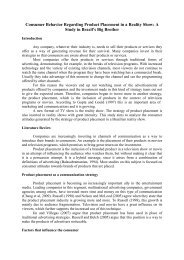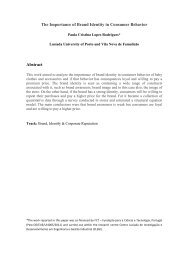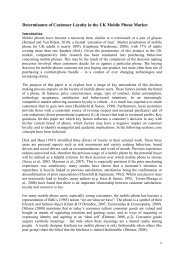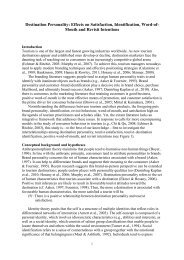The Vacation Lottery: Exploring the relationship between the ...
The Vacation Lottery: Exploring the relationship between the ...
The Vacation Lottery: Exploring the relationship between the ...
Create successful ePaper yourself
Turn your PDF publications into a flip-book with our unique Google optimized e-Paper software.
Travelling with Disabilities in a Digital Age<br />
Generally, advances within technology (eg internet, e-mail, social media/social<br />
networking sites, smartphones etc) are applauded for providing greater access and<br />
engagement to consumers. <strong>The</strong>y are frequently reported as empowering us to<br />
participate, ei<strong>the</strong>r individually or collectively, in society, through affiliations (eg<br />
social networking sites such as Facebook) and opportunities for self-expression (eg<br />
review websites) (Burton & Kammash, 2010; Litvin et al., 2008). <strong>The</strong>re is an implicit<br />
assumption that we as a society are benefitting from <strong>the</strong>se advances. Whe<strong>the</strong>r we are<br />
<strong>the</strong> ‘digital natives’ of Generation Y, Z and beyond, or <strong>the</strong> digital immigrants of<br />
previous generations (Prensky, 2001), technological advances are <strong>the</strong>re to facilitate<br />
and enhance our life experiences. However, this paper challenges this line of thinking<br />
and argues instead that <strong>the</strong> <strong>relationship</strong> <strong>between</strong> consumption and technology is far<br />
more complicated than necessarily appreciated. More specifically, <strong>the</strong> aim of <strong>the</strong><br />
paper is to explore <strong>the</strong> <strong>relationship</strong> by examining <strong>the</strong> leisure travel of disabled<br />
consumers from a technological perspective.<br />
Leisure travel is not accessible to all, with economic factors most commonly cited as<br />
a primary reason for constrained participation. Economic constraints represent only<br />
one part of <strong>the</strong> picture though with <strong>the</strong>ir contribution often over-simplified. Health<br />
and disability factors, at times <strong>the</strong> cause of economic hardship, be it short or longterm,<br />
are of at least equal significance yet remain infrequently considered. Such is<br />
particularly problematic given <strong>the</strong> capacity of <strong>the</strong>se factors to cut across <strong>the</strong> economic<br />
divide. <strong>The</strong> comment by Shaw and Coles (2004, p 399) that "few, if any of <strong>the</strong> social<br />
constructs of disability have permeated <strong>the</strong> tourism literature. <strong>The</strong>re has been a<br />
reluctance to explore <strong>the</strong> experiences of <strong>the</strong> disabled traveller, in addition to<br />
neglecting <strong>the</strong> wider <strong>relationship</strong> <strong>between</strong> disabled people and <strong>the</strong> tourism industry" is<br />
particularly pertinent to this paper as such criticism can equally be levied at our<br />
current understanding of <strong>the</strong> technological access and engagement of <strong>the</strong>se<br />
consumers. Consequently, <strong>the</strong> paper questions whe<strong>the</strong>r, and which forms of<br />
technology enhance tourism participation for disabled tourists today. Similarly it also<br />
questions which problems arise for associated consumers as a consequence of<br />
technological advances.<br />
Understanding <strong>the</strong> travel needs of <strong>the</strong> disabled community is complicated as only a<br />
narrow research agenda has been pursued to date. Three common areas of study exist.<br />
First, that which identifies <strong>the</strong> disabled community as a lucrative market segment<br />
waiting to be tapped. Second, that which considers <strong>the</strong> advantages of tourism<br />
participation for constrained consumers. Third, that which considers <strong>the</strong> constraints<br />
and barriers to participation <strong>the</strong> disabled community experiences.<br />
Investigating <strong>the</strong> <strong>relationship</strong> <strong>between</strong> tourism participation and serious illness,<br />
specifically cancer, Hunter-Jones (2004) identified <strong>the</strong> positive contribution of travel<br />
to wellbeing. Personal health, social effectiveness, personal identity and regaining<br />
independence were each identified as benefits of tourism participation. <strong>The</strong>se benefits<br />
are important and are generally reviewed within two contexts: physical benefits;<br />
psychological benefits. More broadly physical benefits have commonly been linked to<br />
active leisure participation. Gratton and Tice (1989) for instance contrasted<br />
participation with non-participation under four general headings namely health status,<br />
health attitudes, health lifestyles and leisure orientation. <strong>The</strong>y found <strong>the</strong>re to be a


